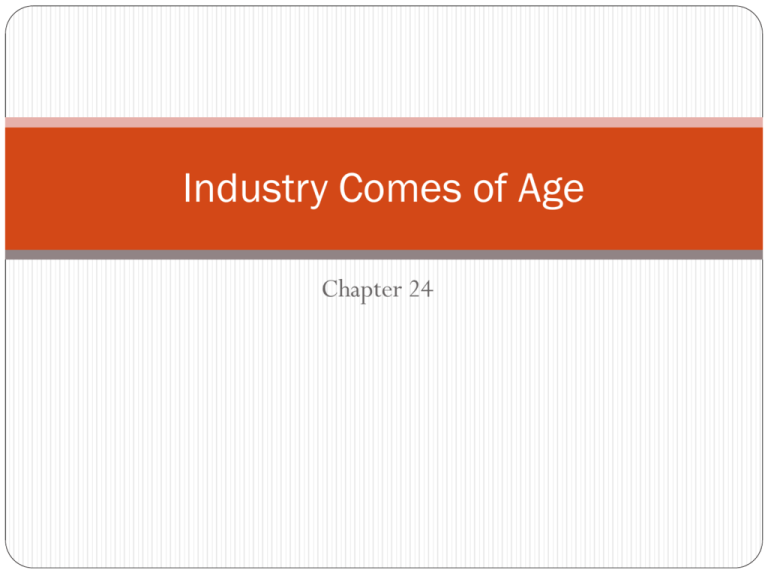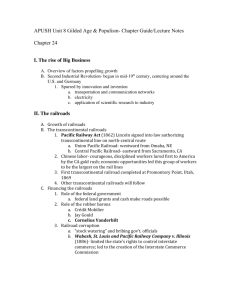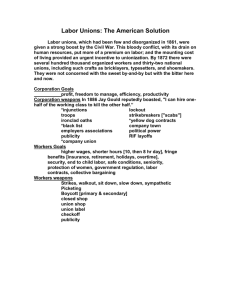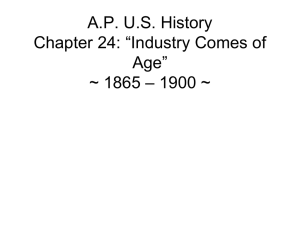Industry Comes of Age
advertisement

Industry Comes of Age Chapter 24 The Iron Colt Becomes the Iron Horse When Lincoln was shot in 1865, there were only 35,000 miles of steam railways in the U.S., mostly east of the Mississippi. By 1900 the figure had spurted up to 192,556 miles, or more than that for all of Europe combined, and much of the new trackage ran west of the Mississippi. The Iron Colt Becomes the Iron Horse Frontier villages touched by the magic wand of the iron rail became flourishing cities; those that were bypassed often withered away and became “ghost towns”. Spanning the Continent with Rails The Union Pacific Railroad- note the word Union- was commissioned by Congress to thrust westward from Omaha, Nebraska. For each mile of track constructed, the company was granted 20 square miles of land, alternating in 640-acre sections on either side of the track. For each mile the builders were also to receive a generous federal loan, ranging from $16,000 on the flat prairie land to $48,000 for mountainous country. Spanning the Continent with Rails Rail laying at the California end was undertaken by the Central Pacific Railroad. A “wedding of the rails” was finally consummated near Ogden, UT in 1869, as two locomotives gently kissed cowcatchers. In all, the Union Pacific built 1,085 miles, the Central Pacific 689 miles. Railroad Consolidation and Mechanization Two significant new improvements proved a boon to the railroads. The steel rail, which Cornelius Vanderbilt helped popularize. A standard gauge of track width Other improvements were the Westinghouse air brake and the Pullman Palace Cars. Revolution by Railways The screeching iron horse especially stimulated mining and agriculture in the West. It took farmers out to their land, carried the fruits of their toil to market and brought them their manufactured necessities. Revolution by Railways Railroad companies also stimulated the mighty stream of immigration. Seeking settlers to whom their land grants might be sold at a profit, they advertised seductively in Europe and sometimes offered to transport the newcomers free to their farms. Wrongdoing in Railroading Jay Gould was the most adept of the railroad ringmasters of rapacity. For nearly 30 years, he boomed and busted the stocks of the Erie, the Kansas Pacific, the Union Pacific, and the Texas and Pacific in an incredible circus of speculative skullduggery. One of the favorite devices of the moguls of manipulation was “stock watering”. Wrongdoing in Railroading Stock watering was the practice of railroad stock promoters grossly inflating their claims about a given line’s assets and profitability and then sell the stocks and bonds far in excess of the railroad’s actual value. Government Bridles the Iron Horse In 1886 the Supreme Court decreed that individual states had no power to regulate interstate commerce in the case of Wabash v. Illinois. If the mechanical monster was to be corralled, the federal government would have to do the job. In 1887 Congress passed the Interstate Commerce Act. Government Bridles the Iron Horse The Interstate Commerce Act; Prohibited rebates and pools Required rates to be published openly Forbade unfair discrimination against shippers Outlawed charging more for a short haul than a long haul on the same line Set up the Interstate Commerce Commission (ICC) to administer and enforce the new legislation Government Bridles the Iron Horse Despite acclaim, the Interstate Commerce Act did not represent a popular victory over corporate wealth. What the new legislation did do was to provide an orderly forum where competing business interests could resolve their conflicts in peaceable ways. The country could now avoid ruinous rate wars among the railroads. It was the first large-scale attempt by Washington to regulate business in the interest of society at large. Miracles of Mechanization Between 1860 and 1890, some 440,000 patents were issued. Business operations were facilitated by machines such as the cash register, the stock ticker, and the typewriter. One of the most ingenious inventions was the telephone, introduced by Alexander Graham Bell in 1876. Miracles of Mechanization Thomas Alva Edison had been considered so dull-witted that he was taken out of school. Wondrous inventions poured out of his “invention factory” in New Jersey- the phonograph, the mimeograph, the dictaphone, and the moving picture. He is best known for his perfection of the electric lightbulb. People now slept just a bit more than seven hours each night instead of nine as they had previous. The Trust Titan Emerges Andrew Carnegie pioneered the creative entrepreneurial tactic of vertical integration, which combined into one organization all phases of manufacturing from mining to marketing. His goal was to improve efficiency of making supplies more reliable, controlling the quantity of the product at all stages of production, and eliminating middlemen’s fees. The Trust Titan Emerges John D. Rockefeller was the mastermind behind the less enviable horizontal integration, which simply meant allying with competitors to monopolize a given market. J.P. Morgan used a different tactic to get ahead in business; he sought to consolidate rival enterprises to ensure harmony by placing officers of his own banking syndicate on their boards of directors, which became known as interlocking directories. Rockefeller Grows an American Beauty Rose Kerosene, derived from petroleum, was the first major product of the infant oil industry. By the 1870s kerosene was America’s 4th most valuable export. In 1870 Rockefeller organized the Standard Oil Company of Ohio. Rockefeller Grows an American Beauty Rose Locating his refineries in Cleveland, he sought to eliminate the middlemen and squeeze out competitors. By 1877 Rockefeller controlled 95% of all oil refineries in the country. The Gospel of Wealth Steel baron Andrew Carnegie felt that the wealthy, entrusted with society’s riches, had to prove themselves morally responsible according to a “Gospel of Wealth.” Most advocates of wide-open capitalism relied heavily upon the idea of survival-of-the-fittest, which is often mislabeled as Social Darwinism. Advocates of Social Darwinism argue that individuals won their stations in life by competing on the basis of their natural talents. Government Tackles the Trust Evil In 1890 the Sherman Anti-Trust Act was signed into law. The Act flatly forbade combinations in restraint of trade, without any distinctions between “good” and “bad” trusts. The law proved ineffective largely because it had only baby teeth or no teeth at all because of the legal loopholes. Government Tackles the Trust Evil Contrary to its original intent, the law was used to curb labor unions or labor combinations that were deemed to be restraining trade. Not until 1914 were the paper jaws of the Sherman Act fitted with reasonable sharp teeth. The South in the Age of Industry Southern agriculture received a welcome boost in the 1880s, when machine-made cigarettes replaced the rollyour-own variety. James Buchanan Duke took full advantage and absorbed his main competitors into the American Tobacco Company. The cigarette czar later showed generosity to Trinity College near his birthplace in Durham, NC. Trustees were so grateful that they changed the name of the school to Duke University. In Unions There is Strength In America, the worker was becoming a lever- puller in a giant mechanism. New machines displaces workers and employers could take full advantage of the vast new railroad network and bring in unemployed workers, from the four corners of the country and beyond. Individual workers were powerless to battle singlehandedly against giant industry. In Unions There is Strength Employers could pool vast wealth through thousands of stockholders, retain high-priced lawyers, buy up the local press, and put pressure on the politicians. They could import strikebreakers (“scabs”) and employ thugs to beat up labor organizers. Employers could also call upon the federal courtspresided over by well-fed and conservative judges- to issue injunctions ordering the strikers to cease striking. In Unions There is Strength If defiance and disorder ensued, the company could request the state and federal authorities to bring in troops. Employers could put the names of agitators on a “black list” and circulate it among fellow employers. Labor Limps Along Labor unions, which had been few and disorganized in 1861, were given a strong boost by the Civil War. The war, with its drain on human resources, put more of a premium on labor. By 1872 there were several hundred thousand organized workers and thirty-two national unions; bricklayers, typesetters, and shoemakers. Labor Limps Along The National Labor Union, organized in 1866 aimed to unify workers across locales and trades to challenge their ever more powerful bosses. The union lasted 6 years and attracted more than 600,000 members, including the skilled, unskilled, and farmers, though in keeping with the times, it excluded the Chinese and made only nominal efforts to include women and blacks. Labor Limps Along National Labor Union agitated for the arbitration of industrial disputes and the eight-hour workday, winning the latter for government workers. A new organization- the Knights of Labor- seized the torch dropped by the defunct National Labor Union. A welcome mat was rolled out for the skilled and unskilled, for men and women, for whites and blacks. The Knights barred only “nonproducers”- liquor dealers, professional gamblers, lawyers, bankers, and stockbrokers Unhorsing the Knights of Labor The Knights became involved in a number of May Day strikes in 1886, about half of which failed. Tensions rapidly built up to the bloody Haymarket Square episode. Labor disorders had broken out, and on May 4, 1886, the Chicago police advanced on a meeting called to protest alleged brutalities by the authorities. Suddenly a dynamite bomb was thrown that killed or injured several dozen people, including police. Unhorsing the Knights of Labor The Haymarket Square bomb helped blow the props from under the Knights of Labor. They were associated, wrongly, with the anarchists that had actually thrown the bomb. Another fatal handicap of the Knights was their inclusion of both skilled and unskilled workers. The AF of L to the Fore The elitist American Federation of Labor, born in 1886, was largely the brainchild of Samuel Gompers. He was elected president of the American Federation of Labor every year except one from 1886 to 1924. A major goal of Gompers was the “trade agreement” authorizing the closed shop- or allunion labor. The AF of L to the Fore Though hard-pressed by big industry, the federation was basically nonpolitical,. But it did attempt to persuade members to reward friends and punish foes at the polls. Labor disorders continued, peppering the years from 1881 to 1900 with a total of over 23,000 strikes. These disturbances involved 6,610,000 workers, with a total loss to both employers and employees of $450 million. As a sign of the times, Labor Day was made a legal holiday by act of Congress in 1894.







